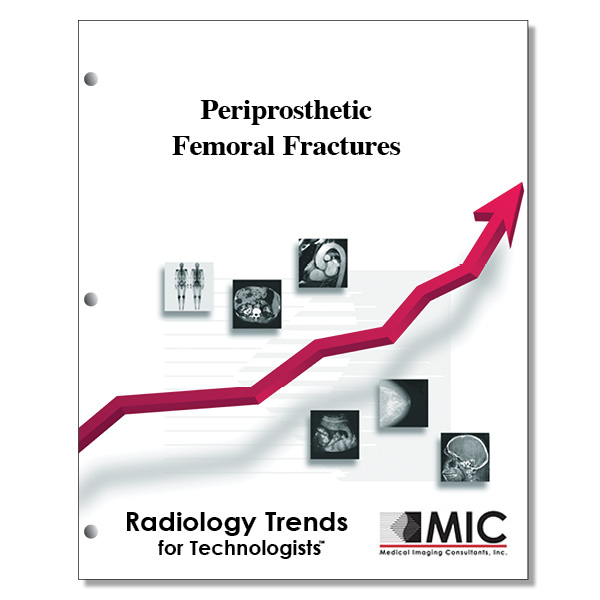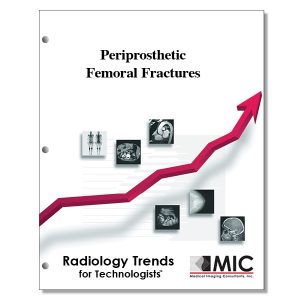

Periprosthetic Femoral Fractures
A review of the normal appearance of common femoral prostheses, the risk factors and mechanisms of periprosthetic femoral fractures, and the most common femoral fracture patterns encountered in the emergency department.
Course ID: Q00534 Category: Radiology Trends for Technologists Modalities: CT, Radiography2.5 |
Satisfaction Guarantee |
$29.00
- Targeted CE
- Outline
- Objectives
Targeted CE per ARRT’s Discipline, Category, and Subcategory classification for enrollments starting after January 30, 2024:
[Note: Discipline-specific Targeted CE credits may be less than the total Category A credits approved for this course.]
Computed Tomography: 0.25
Procedures: 0.25
Head, Spine, and Musculoskeletal: 0.25
Radiography: 0.50
Procedures: 0.50
Head, Spine and Pelvis Procedures: 0.50
Registered Radiologist Assistant: 0.50
Procedures: 0.50
Musculoskeletal and Endocrine Sections: 0.50
Outline
- Introduction
- Evaluation of Hip Prostheses in the ED
- Common Prostheses and Expected Radiographic Appearance
- Fracture Risk and Etiology
- Vancouver Classification System
- Fracture Location
- Prosthesis Stability
- Traumatic Loosening
- Atraumatic Loosening
- Quality of Femoral Bone Stock
- Severity of Bone Loss
- Location of Bone Loss
- Application of the Vancouver Classification: Clinical Examples and Management Implications
- Patient 1
- Discussion
- Patient 2
- Discussion
- Patient 3
- Discussion
- Patient 4
- Discussion
- Patient 5
- Discussion
- Patient 1
- Limitations of the Vancouver Classification System
- Conclusion
Objectives
Upon completion of this course, students will:
- understand the factors contributing to an increase in the number of THAs performed annually
- know the strongest negative prognostic indicator for postrevision arthroplasty
- know the optimum strategy for evaluating periprosthetic fractures
- know the optimum strategy for managing periprosthetic fractures
- be familiar with the role of radiography in patients with THA who present with hip pain
- understand the role of nonenhanced MDCT of the hip in patients with THA
- know what factors may hinder nonenhanced MDCT In the setting of a femoral prosthesis
- understand what stress shielding is
- be familiar with the radiographic appearance of press-fit hip prostheses
- be familiar with the radiographic appearance of cemented hip prostheses
- know the most common risk factors associated with postoperative periprosthetic fractures
- know the causes of hip prosthesis loosening
- understand when an implant is considered stable
- understand when an implant is considered unstable
- be familiar with the major radiographic characteristics used by the Vancouver classification
- be familiar with the three anatomic zones used in the Vancouver classification system to characterize fracture location
- describe the features of a Vancouver AGT periprosthetic fracture
- describe the features of a Vancouver ALT periprosthetic fracture
- understand why Vancouver A periprosthetic fractures are treated conservatively
- describe the features of a Vancouver B1 periprosthetic fracture
- describe the features of a Vancouver B2 periprosthetic fracture
- describe the features of a Vancouver B3 periprosthetic fracture
- describe the features of a Vancouver C periprosthetic fracture
- list the three mechanisms that can cause disruption of the periprosthetic fixation interface
- know the indications for atraumatic loosening for cemented prostheses
- know the indications for atraumatic loosening for press-fit prostheses
- be familiar with why high-quality femoral bone stock is important
- know the findings that are indicative of severe bone loss
- know the findings that are indicative of nonsupportive bone
- understand the importance of describing the distribution of bone loss in patients with a loose prosthesis and bone loss
- know the percentage of periprosthetic femoral fractures that are classified as Vancouver B1
- know the percentage of periprosthetic femoral fractures that are located along the femoral stem
- be familiar with the clinical presentation of the five patients discussed in the article
- understand the treatment rationale for the five patients discussed in the article
- be familiar with the standard of reference for loosening and poor bone stock when assessing a femoral prosthesis
